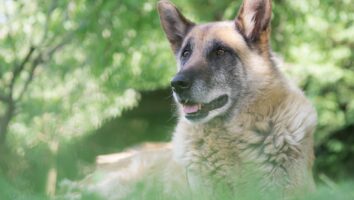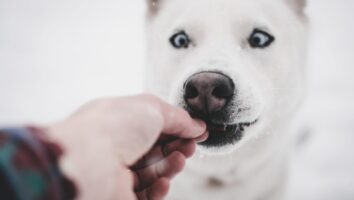Dog
Heat Stroke (Hyperthermia) in Dogs
Dogs cannot regulate their temperature by sweating, like humans. Instead, dogs pant to cool their body. Unfortunately, this isn’t always an effective way to avoid overheating. If the surrounding air…
Brushing Your Dog's Teeth: Step-by-Step Instructions
As soon as you get that new puppy, be sure to get them used to having their teeth brushed! They’re kinda like a ball of clay when they’re young and will be more agreeable to trying new things. Old…
Poisonous Plants for Dogs and Cats: Dieffenbachia
Dieffenbachia is a genus of perennial, tropical, flowering plants that are widely sold and commonly kept as houseplants due to their tolerance of shade and their pretty and varied appearances. If…
Everything You Need to Know About Vomiting in Dogs
Unfortunately, vomit happens. And while it can be scary to see your dog throw up, it’s helpful to know what might be causing the problem, and if there’s anything you can do about it without taking…
How to Feed and Care for Newborn Puppies
Have you ever wondered what it’s like to care for newborn puppies? What should you watch out for? What if the mama is no longer around? Read on to learn the basics!
Top 3 Diseases of the Surface of the Eye (Cornea) in Dogs
Any disease affecting the surface of the eye can threaten vision. Therefore, it’s important to treat them quickly and effectively. Below is a summary of the most common corneal conditions affecting…
Can dogs catch colds?
If your dog is coughing and has a runny nose, you may be wondering if she has a common cold. It’s important to know that dogs can show cold-like symptoms due to a variety of causes including…
The Importance of Kidney Health and Function in Dogs and Cats
Dogs and cats, like all mammals, have kidneys that perform many vital life functions. Keeping these organs healthy and recognizing early signs of disease can help your pet live a long, happy life.…
Your Pet’s Heart: A Guide to Understanding Heart Health in Dogs and Cats
Have you ever considered what an important function the heart serves? The heart beats continuously to move blood throughout the body, every day, all day for the entirety of your pet’s life. This…
Anatomy and Function of Your Pet’s Eyes
Dogs’ and cats' eyes work similarly to our eyes and can develop similar eye problems like cataracts, glaucoma, and more. Read on to learn some fun and interesting facts about the anatomy of the eye,…
Reverse Sneezing in Dogs
Reverse sneezing in dogs is a rather common occurrence but can be very distressing to witness, especially for the first time! When dogs reverse sneeze, it looks like they’re having a hard time…
Laryngeal Paralysis in Dogs
Laryngeal paralysis is a medical condition affecting dogs, where the muscles in the larynx are no longer able to move the arytenoid cartilages open and closed. The larynx is part of the upper…
Horner’s Syndrome in Dogs and Cats: What to Look for in Your Pet
Horner’s Syndrome is not a disease itself, but a combination of clinical symptoms that can have multiple potential causes. While this can affect dogs and cats of any age, from juveniles to senior…
Common Causes of Coughing in Dogs
A common concerning symptom you may notice in your dog is a new cough. Is this something to worry about? What could be causing it? Follow below for more information regarding the common causes of…
How to Give Your Dog Oral Medication
Giving a dog his medicine is rarely easy, but knowing the proper procedure and what to expect can make the process more pleasant — for you and your dog. To start, prepare all the medications that…
Caring for Your Pregnant Dog
Having puppies may sound easy and fun, but there is actually quite a bit of work that you need to do both before and after your dog gives birth. Proper planning and care can do a lot to minimize…
Panosteitis in Dogs (Growing Pains)
Panosteitis, also known as growing pains, refers to a self-limiting yet painful bone condition involving the long leg bones of young large breed dogs generally between ages 5 and 18 months.…
Brachycephalic Syndrome in Dogs
Brachy means shortened and cephalic means head. Therefore, brachycephalic dogs have skull bones that are shortened in length, giving the face and nose a pushed-in or “smoosh-face” appearance. Common…
























